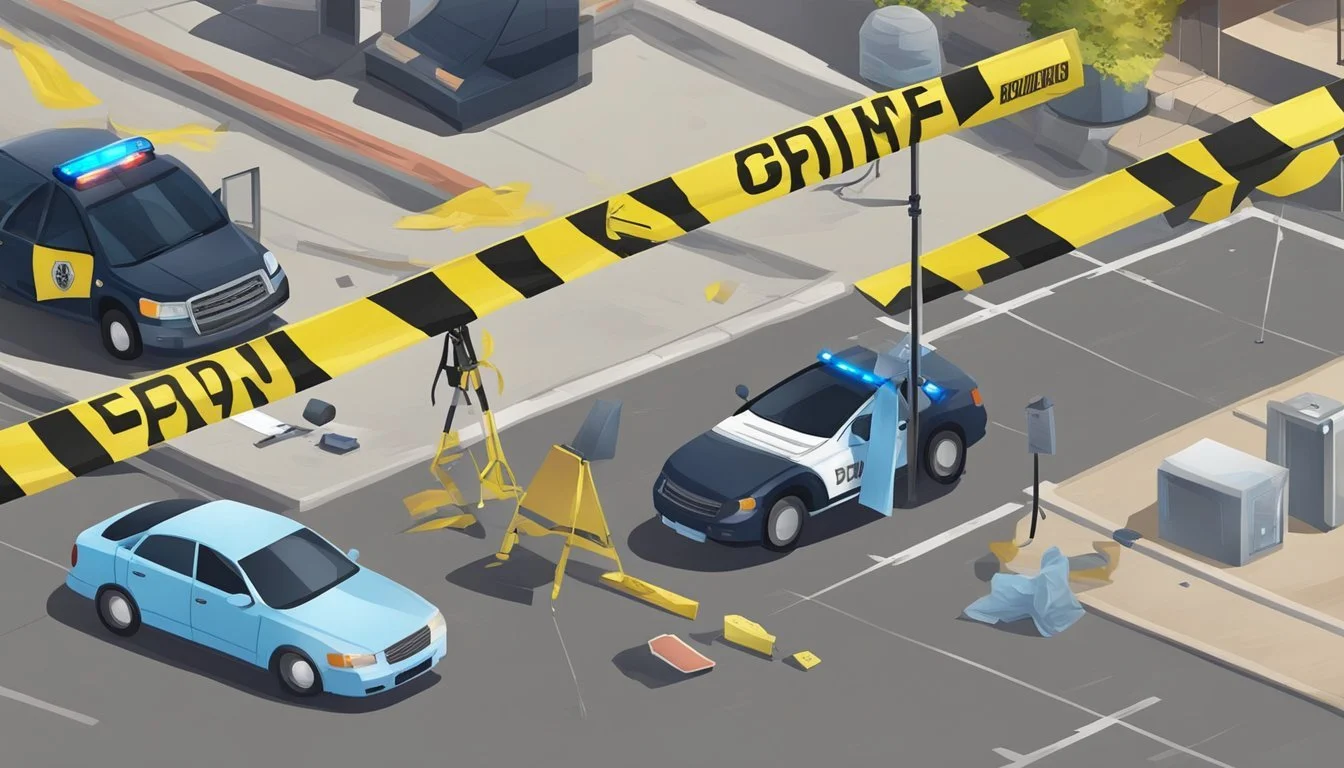1997: The Year JonBenét Ramsey's Murder Shocked America—Uncover the Twists and Turns!
The unsolved murder of JonBenét Ramsey captivated the nation in 1997. Six-year-old JonBenét, a child beauty queen, was found dead in her family's home in Boulder, Colorado on December 26, 1996. Her death sparked intense media coverage and a complex investigation that continued throughout 1997 and beyond.
The case took many twists and turns in 1997 as investigators pursued leads and the Ramsey family came under scrutiny. In March, JonBenét's autopsy report was partially released, revealing she had suffered a skull fracture and had been sexually assaulted. This information fueled further speculation about potential suspects and motives.
As 1997 progressed, the investigation faced numerous challenges. The crime scene had been contaminated, evidence was disputed, and conflicting theories emerged. The Ramsey parents, John and Patsy, gave their first media interviews that year while also falling under suspicion themselves. Despite extensive police work, the case remained unsolved, leaving many questions unanswered and a community searching for justice.
Background of JonBenét Ramsey
JonBenét Ramsey was a young beauty pageant contestant whose tragic murder in 1996 captured national attention. Her family background and public image as a child beauty queen became central elements of the case.
Family Profile
JonBenét Patricia Ramsey was born on August 6, 1990, in Atlanta, Georgia. Her parents were John Bennett Ramsey, a successful businessman, and Patricia "Patsy" Ramsey, a former beauty queen. JonBenét had an older brother named Burke.
The Ramseys were a wealthy family living in Boulder, Colorado at the time of JonBenét's death. John Ramsey was the president of Access Graphics, a computer services company. Patsy Ramsey was a stay-at-home mother who had previously won the Miss West Virginia pageant in 1977.
Beauty Pageants and Public Image
JonBenét participated in numerous child beauty pageants from a young age. She won several titles, including Little Miss Colorado and National Tiny Miss Beauty. Her participation in these contests was encouraged by her mother Patsy.
Photos of JonBenét in full makeup and elaborate costumes became widely circulated after her death. These images sparked debates about the appropriateness of child beauty pageants. Critics argued such contests sexualized young girls.
JonBenét's public image as a child beauty queen contrasted sharply with the brutal nature of her murder. This dichotomy fueled media interest in the case and shaped public perceptions of the investigation.
The Crime Scene
The JonBenét Ramsey crime scene was complex and challenging for investigators. Key elements included a ransom note, the victim's body found in the basement, and various pieces of evidence scattered throughout the Ramsey home.
Discovery of the Ransom Note
Patsy Ramsey discovered a 2.5-page ransom note on the kitchen staircase on December 26, 1996. The note demanded $118,000 for JonBenét's safe return. It was written on paper from a notepad found in the house, using a Sharpie pen also belonging to the Ramseys.
The note's length and detailed content were unusual for a kidnapping scenario. Investigators later determined it was likely written inside the Ramsey home, raising questions about the intruder theory.
JonBenét's Body and the Ramsey Home
JonBenét's body was found in a little-used basement room by her father, John Ramsey, around 1:00 PM on December 26. She had been strangled with a garrote made from a white cord and a broken paintbrush handle.
The 7,000-square-foot Ramsey home presented challenges for crime scene analysis. Evidence was scattered across multiple rooms:
Basement: Victim's body, broken paintbrush pieces
Kitchen: Ransom note, pineapple bowl
JonBenét's bedroom: Signs of a struggle
Investigators noted no signs of forced entry. The absence of footprints in the snow outside raised suspicions about an inside job. The crime scene's complexity and initial mishandling complicated the investigation significantly.
Investigation Details
The JonBenét Ramsey case involved a complex investigation with multiple agencies and forensic techniques. Key aspects included the initial police response, evidence collection, and advanced forensic analysis.
Initial Response by Law Enforcement
Boulder Police Department responded to the Ramsey home on December 26, 1996, after JonBenét's mother reported her missing. Detective Linda Arndt was among the first officers on scene.
The initial response was criticized for not securing the crime scene properly. Several people, including family friends, were allowed to move freely through the house.
At 1:05 PM, JonBenét's body was discovered in the basement by her father, John Ramsey. This altered the nature of the investigation from a kidnapping to a homicide.
Evidence Collected
Investigators gathered numerous pieces of evidence from the Ramsey home. Key items included:
The ransom note, found on the kitchen staircase
Fibers from various locations in the house
DNA samples from JonBenét's clothing and body
The cord and duct tape used to bind JonBenét
A broken paintbrush, believed to be part of the garrote used in the crime
Forensic teams also examined the point of entry, suspecting the killer may have entered through a basement window.
DNA Technology and Handwriting Analysis
DNA evidence played a crucial role in the investigation. In 1997, male DNA was found on JonBenét's underwear and longjohns. This DNA did not match any family members.
As technology advanced, the DNA was further analyzed in 2008 using touch DNA techniques. The results supported the theory of an unknown male perpetrator.
Handwriting experts examined the ransom note extensively. While some experts believed Patsy Ramsey could have written it, others disagreed. The results were ultimately inconclusive.
The 911 call made by Patsy Ramsey was also analyzed for background noise and voices, but no definitive conclusions were reached.
Medical Examination
The medical examination of JonBenét Ramsey revealed crucial details about her injuries and cause of death. Key findings included evidence of sexual assault and strangulation.
Autopsy Findings
The autopsy report, released in March 1997, provided important insights into JonBenét's death. The examination found a skull fracture and signs of sexual assault. Bruising and abrasions were noted on various parts of her body. The coroner determined the cause of death to be asphyxia by strangulation associated with craniocerebral trauma.
Evidence of bleeding in JonBenét's genital area indicated she was alive when sexually assaulted. The autopsy also revealed no prior history of sexual abuse, contradicting some initial speculations.
Time of Death and Injuries Analysis
Forensic pathologists estimated JonBenét's time of death to be in the early hours of December 26, 1996. The skull fracture was likely caused by a blunt force trauma to the head. Analysis of her injuries suggested the strangulation occurred after the head injury.
The garrote used in the strangulation left distinct marks on her neck. Experts noted that the placement and tightness of the garrote indicated it was likely applied by an adult.
Toxicology tests found no drugs or foreign substances in JonBenét's system at the time of death.
Suspects and Theories
The JonBenét Ramsey case generated numerous suspects and theories over the years. Investigations focused on both the Ramsey family and potential intruders, with several persons of interest emerging.
Ramsey Family
John and Patsy Ramsey, JonBenét's parents, faced intense scrutiny. Some investigators believed they were involved due to inconsistencies in their statements and behavior. Burke Ramsey, JonBenét's brother, was also considered a suspect by some.
Theories suggested Patsy may have accidentally killed JonBenét in a fit of rage, with John helping cover it up. Others proposed Burke was responsible, with the parents protecting him.
However, DNA evidence found on JonBenét's clothing did not match any family members. In 2008, a prosecutor officially cleared the Ramseys based on this new evidence.
Intruder Theory
The intruder theory gained traction due to evidence of a possible break-in. Investigators found an open basement window and a footprint nearby.
Some experts believed an intruder entered the house, wrote the ransom note, and committed the crime. This theory was supported by:
Unidentified DNA on JonBenét's clothing
A partial palm print on the cellar door
Reports of suspicious individuals in the area
Critics argued that the lack of clear signs of forced entry and the detailed ransom note made this scenario less likely.
Persons of Interest
Several individuals were investigated as potential suspects:
John Mark Karr: Confessed to the murder in 2006 but was later cleared by DNA evidence.
Gary Oliva: A convicted pedophile who allegedly confessed to the crime in letters from prison.
Michael Helgoth: A local man who died by suicide shortly after the murder.
John Brewer Eustace: Investigated after committing a similar crime in North Carolina.
Private investigators hired by the Ramseys also pursued various leads and theories. Despite extensive investigations, no definitive suspect has been identified, leaving the case unsolved to this day.
Media and Public Reaction
The JonBenét Ramsey case sparked intense media coverage and public fascination in 1997. News outlets and the public speculated wildly about the circumstances surrounding the young girl's death.
Coverage and Speculation
Major news networks devoted extensive airtime to the case, with reporters camped outside the Ramsey home in Boulder, Colorado. Tabloids plastered JonBenét's pageant photos across their covers, fueling public interest.
Speculation ran rampant, with armchair detectives and TV pundits offering theories about potential suspects and motives. The investigation's slow progress led to increased scrutiny of the Boulder Police Department's handling of the case.
Social media platforms, though in their infancy, buzzed with discussions and amateur sleuthing attempts. Online forums dedicated to the case emerged, where users debated evidence and shared their own theories.
Impact on the Ramsey Family
John and Patsy Ramsey faced intense media scrutiny and public suspicion. They granted an interview to CNN on January 1, 1997, where Patsy proclaimed "there is a killer on the loose."
The couple hired a public relations firm to manage their media interactions. They also engaged legal representation to protect their interests during the investigation.
The constant media presence outside their home forced the Ramseys to relocate temporarily. Their privacy was severely compromised, with paparazzi following their every move.
The intense public speculation took a toll on the family's reputation and personal lives. They faced criticism for JonBenét's involvement in child beauty pageants, which some viewed as inappropriate.
Legal Proceedings and Advocacy
The JonBenét Ramsey case sparked numerous legal actions and advocacy efforts. The Ramsey family faced intense scrutiny while seeking justice, and victim advocates played a crucial role in supporting the family and raising awareness about child safety issues.
Legal Actions by the Ramsey Family
John and Patsy Ramsey filed multiple defamation lawsuits against media outlets and individuals who accused them of involvement in their daughter's death. In 2002, they sued Fox News for $12 million over a report linking them to the crime. The case was settled out of court.
The Ramseys also took legal action against former Boulder police detective Steve Thomas, who wrote a book implicating Patsy in JonBenét's murder. This lawsuit was settled in 2002, with Thomas retracting his allegations.
In 2003, U.S. District Judge Julie Carnes ruled that the evidence in the case was more consistent with an intruder theory than family involvement. This ruling bolstered the Ramseys' position and led to further legal developments.
Role of Victim Advocates
Victim advocates played a significant role in supporting the Ramsey family and bringing attention to the case. These advocates:
Provided emotional support to the family
Assisted in navigating the complex legal system
Liaised between the family and law enforcement
Organizations like the National Center for Missing and Exploited Children worked to keep JonBenét's case in the public eye. They emphasized the importance of child safety and pushed for improved investigative techniques in cases involving young victims.
Advocates also lobbied for better coordination between law enforcement agencies and prosecutors in Boulder. This effort aimed to address the conflicts that emerged during the initial investigation, which may have hindered progress in solving the case.
Advancements in the Case
The JonBenét Ramsey case has seen significant progress in forensic techniques and DNA analysis since 1997. These advancements have provided new avenues for investigation and renewed hope for solving the decades-old mystery.
Forensic Advancements and Re-examination
Investigators have revisited crime scene evidence using cutting-edge forensic technologies. Advanced fingerprint analysis and digital imaging have allowed for clearer examination of previously collected samples.
Forensic experts have re-analyzed fiber evidence and trace materials found at the scene. This re-examination has yielded new insights into potential suspect profiles and timelines.
Improved forensic pathology techniques have also enabled a more detailed understanding of the injuries sustained by JonBenét. This has helped refine theories about the sequence of events on that fateful night.
Developments in DNA Technology
DNA analysis has been a game-changer in the Ramsey case. Advances in genetic testing have allowed for the extraction and analysis of minute DNA samples previously deemed unusable.
Touch DNA technology has enabled investigators to detect genetic material on items like the ransom note and JonBenét's clothing. This has provided valuable leads and potential suspect profiles.
Recent developments in genetic genealogy have opened new possibilities for identifying suspects. By comparing DNA evidence to public genealogy databases, investigators hope to narrow down potential perpetrators or their relatives.
The Boulder Police Department has partnered with private labs to employ the latest DNA sequencing techniques. These efforts aim to uncover previously undetected genetic clues that could finally crack this cold case.
Memory and Legacy
JonBenét Ramsey's tragic death left an enduring impact on American society. Her memory continues to be honored through various tributes, while the unsolved case remains a topic of public fascination.
Commemoration and Tributes
JonBenét's funeral took place on December 31, 1996, at St. John's Episcopal Church in Boulder, Colorado. Hundreds gathered to pay their respects to the young beauty queen. Her classmates at High Peaks Elementary School held a memorial service, releasing balloons in her honor.
The Ramsey family established a foundation in JonBenét's name to support children's charities. Annual vigils are held in Boulder on the anniversary of her death, bringing together community members to remember her life.
A memorial bench was installed in a local park, serving as a permanent tribute to JonBenét. Her gravesite in Georgia continues to receive visitors and floral tributes from those touched by her story.
Continuing Influence on Popular Culture
JonBenét's case has inspired numerous books, documentaries, and television specials. True crime enthusiasts continue to debate theories about her unsolved murder, keeping the case in the public eye.
The story has been dramatized in films and TV shows, often sparking controversy. Podcasts dedicated to analyzing the case have gained popularity, introducing new generations to JonBenét's story.
Her image as a child beauty queen has prompted discussions about children in pageants. The case has influenced how media covers crimes involving children, leading to more sensitive reporting practices.
JonBenét's legacy extends to forensic science, as her case highlighted the importance of proper evidence collection and preservation in criminal investigations.







